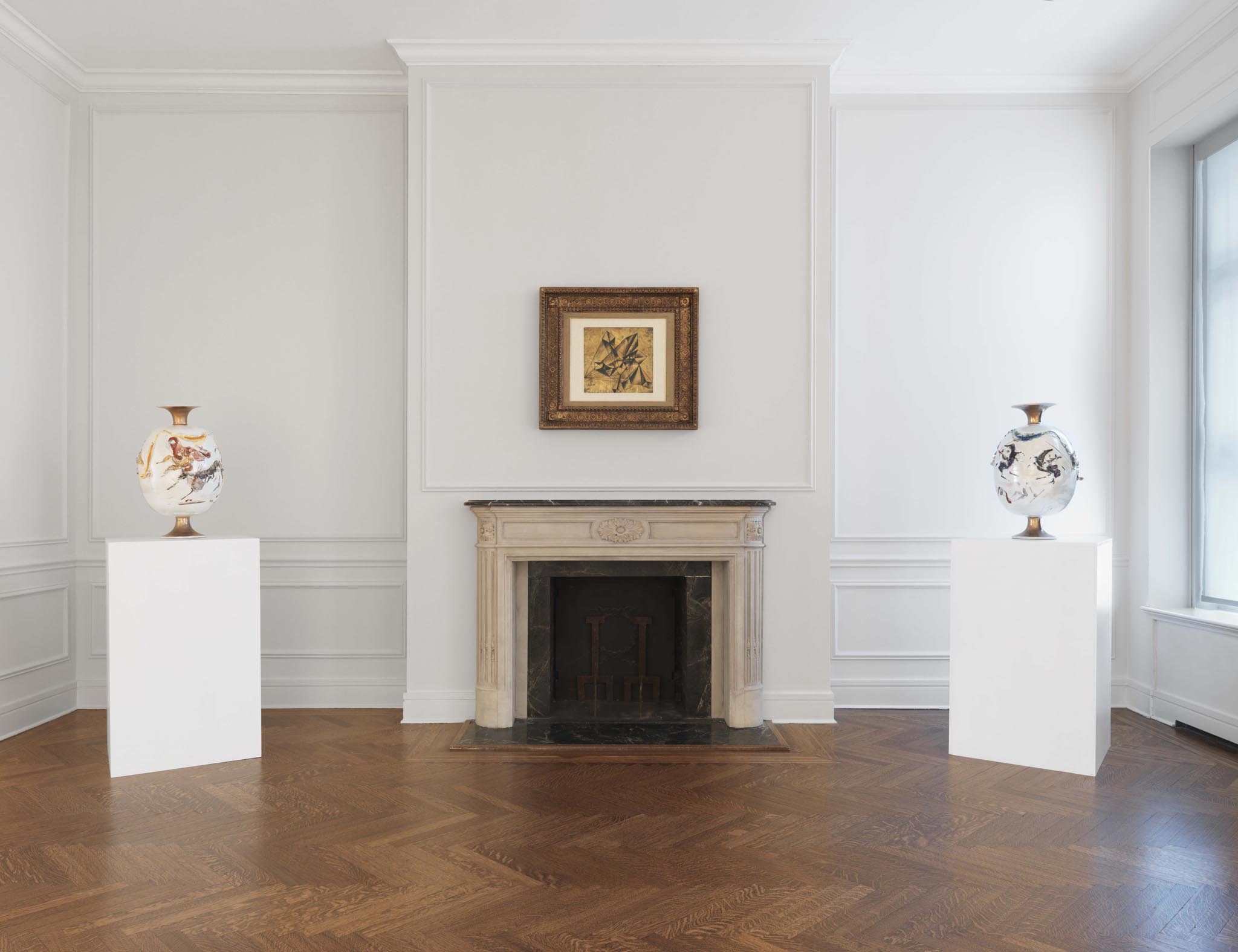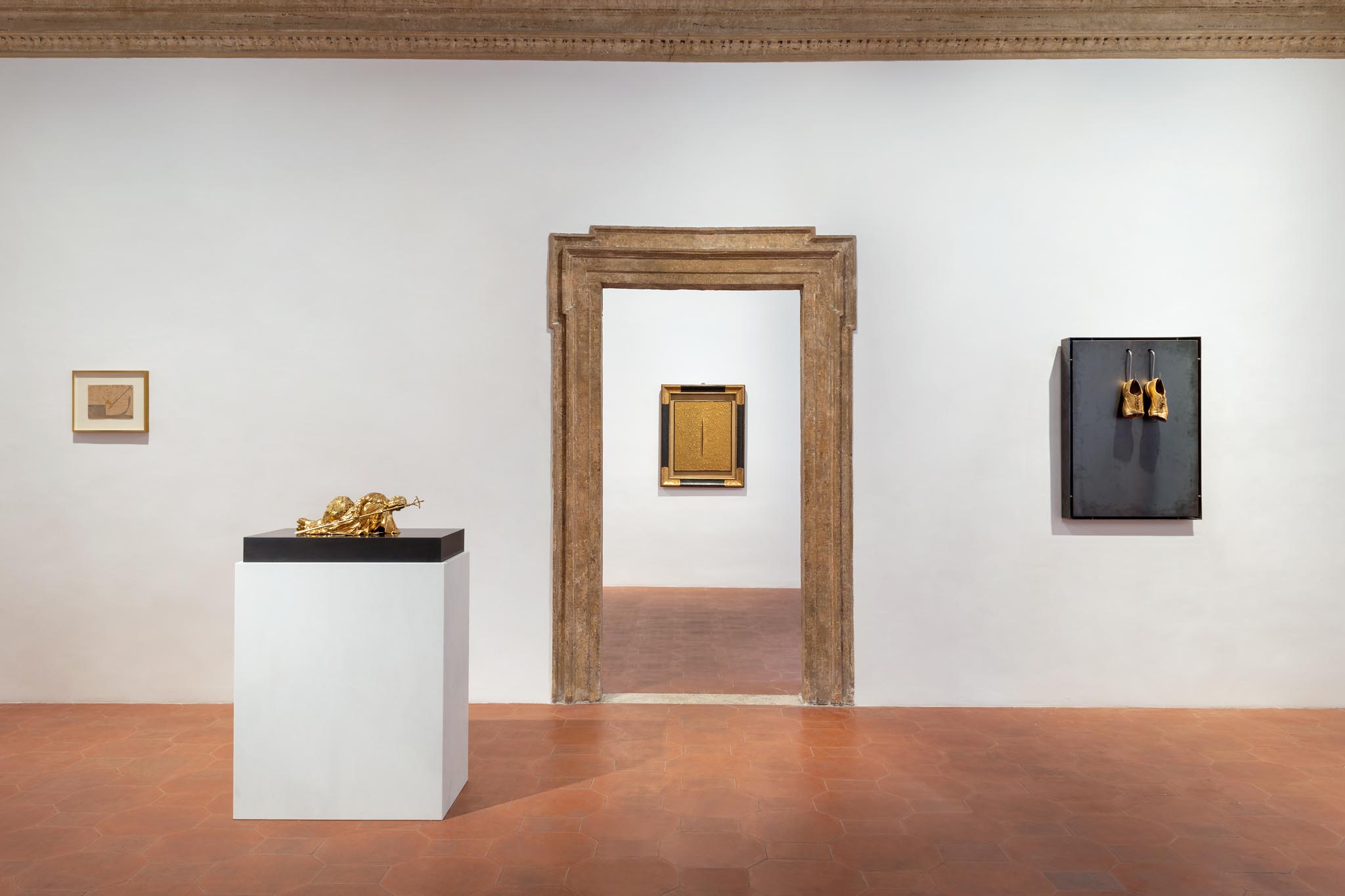Vincenzo Agnetti was born in Milan, graduated from the Brera Academy and attended the Piccolo Teatro School, where he met Bruna Soletti, his future collaborator and life partner. These were also the years of the first artistic experiences in the field of informal painting and poetry, of which, however, unfortunately no trace remains, within an artistic activity covering just under fifteen years: from 1967 to 1981.
A friend of Enrico Castellani and Piero Manzoni, for Agnetti art was an operation of global synthesis, and the artist, by introducing a distinction between making and being, realized a globality in which subjectivity, consciousness and production are an inextricable whole.
In 1962, the artist, while leaving with his family for Argentina, managed to maintain correspondence contacts with the Milanese art world. No works have been preserved from these years either, and yet this was to be the last break Agnetti decided to take before devoting himself entirely to artistic production. In 1967, in fact, he was back in Italy, passing through New York.
Back in Milan he resumed and intensified his friendship with Vanni Scheiwiller, which began in 1958. In 1968, with the novel
Obsolete
, Agnetti inaugurated the series
Denarrators
Scheiwiller’s. The cover was designed by Enrico Castellani, a kind of seal of the intellectual and design partnership that had been the basis of
Azimuth
.
Dating back to 1970 Cyclostyle 1, a list of projects and ideas signed Agnetti that Scheiwiller published almost clandestinely, and also from the early 1970s were his writings, published by Scheiwiller, for artists such as Fausto Melotti, Antonio Calderara, Raimund Girke, Reimer Jochims, Karl Pranti, and Mauro Reggiani published in Contemporary research 1,2,3.
In 1967, Agnetti held his first exhibition at the Palazzo dei Diamanti in Ferrara, where he exhibited a permutable logic entitled
Principia
: a work that visually concretizes the problematic of the relativity of meanings in language. Agnetti’s exhibitions continued: in 1968 he exhibited at the Visualità Gallery the
Drugged machine
.
Continued
is also titled a set of works that clearly and unequivocally testify to his intention to introduce critical discourse into the heart of the art circuit. These are works obtained by photographing on emulsified canvas the pages of the magazine
Domus
which hosted
Copy from the real number one
, a work conceived in 1969 and aimed at describing the evolution-involution of the artistic journey.
In 1970, combining knowledge that came from working in South America, he made the
Neg
, a work capable of vitalizing the negative and which would be revived in 1981 in New York, on the occasion of participation in
Revolution per minute (the art record):
a music album produced by Jeff Gordon and composed of 22 artists, all linked to the Feldman Gallery and all exponents of visual and conceptual art. In February 1971, on the occasion of the exhibition entitled. Redundancy: landscapes and portraits Analysis: axioms…, Agnetti exhibited a series of felts and bakelites at the Galleria Blu in Milan that opened an extremely prolific line of work. In 1972, the Martano 2 Gallery was brought to show the
Telegramm
i: 14 propositions about portable language on the transmitted word.
With
Off limits
1969,
14th-20th centuries
in 1970, and
1870-1974
in 1974, Agnetti intervened on ancient paintings and frescoes owned by a number of collectors, producing works that collectively encapsulate the work of two artists over a certain time span and compare, with lucid and fleshed-out synthesis, languages elaborated centuries apart. And again in 1978 using some old Japanese photographs he decided to turn them into works in which irony and poetry are the determinants of the operation. Time is once again the protagonist in the
Sundials
, o
Tempus mentis
, where the concrete time represented by the sundial, which measures the path of the sun at various times of the day, is compared with the abstract time of philosophical formulations. And Again, in Time action, a series of seven drawings exhibited in 1973 at the Anna Maria Verna Gallery in Zurich, this element is visualized spatially and related to the artistic action. Also within the reflection on time are other works such as the
Pantheistic projects
, i
Telegrams
, l’
Autotelephone
, l’
Average age of A
. e
Of the Changes
.
In 1972, at the Françoise Lambert Gallery in Milan, Agnetti exhibited.
Lost Space
e
Built Space
, works in which the relationship between space and the passage of time is elaborated. In 1973 he finished making
Project for a Political Hamlet
: a form of static theater understood as a performance without movement, without characters and without text.
In the early 1970s, Agnetti was turned to outlining with great mental clarity and considerable conceptual effort, the coordinates underlying his artistic operation that, by the end of the decade would be revisited with renewed poetic yearning. From those years are the interminable discussions with the friends he enthusiastically made to participate in his projects: the dearest collectors including Malabarba, Bertolini and Rimoldi, his gallery owner and supporter Castelli, and then Franco Toselli, Daniela Palazzoli, Pierre Restany, Gregory Battcock, Achille Bonito Oliva, Carla Pellegrini and artists close to him such as Fausto Melotti, Mario and Marisa Merz, Alighiero Boetti.
In 1975 Agnetti was on the road again: he turned his gaze once more to New York City, where he opened a studio in Manhattan, began collaborating with Ronald Feldman, and formed friendships with other artists, notably Shusaku Arakawa. That same year he exhibited at the Sonnabend Gallery in Paris. Events precipitate (1974). The year 1975 is in fact a bridging year, in which the need to take stock, to summarize the state of his art, emerges overwhelmingly in him. For this reason, in his first American exhibition at the Feldman Gallery in New York, Agnetti presented himself with
Image from an exhibition.
, an exhibition previously held in Milan at the Castelli Gallery the previous year.
Artistic production continued along the lines of reflection already traced: language, time, communication, social-political critique. Works of remarkable emotional and visual impact emerged such as the
Elizabeth of England
(1976) and works of great conceptual rigor, such as
Mass Media
(1977).
While rigorously continuing his artistic research in the conceptual sphere, towards the end of the 1970s Agnetti’s poetic soul took over, explanatory captions on the logical-cognitive register became increasingly rare, and mental rigor was diluted in poetry: an example in this sense was The Crime (1977), in which the writing accompanying the photos translates the conceptual operation into poetry.
In 1977, the Israel Museum in Jerusalem mounted the
Mental Installation
, an exhibition that linked together works produced between 1974 and1977:
Six Different Villages, Elizabeth of England, Mass Media, The Crime
. In 1978, Agnetti published with Guanda a book of poems interspersed with images of his works. Title,
Machiavelli 30
, referred to his studio in Milan, the place connected to his artistic life, almost an
insight
into the artist’s inner self.
The year 1980, opened under the banner of sculpture with an exhibition entitled
Surplace
, exhibited by Toselli in Milan and by Feldman in New York. The work consists of four large iron sculptures and four photographs that represent four moments of a performance in one work,
The Lost Letter
, made at Palazzo Grassi in Venice in the summer of 1979.
In the photo-graphs, which are among his last works (1979-81), Agnetti went further: poetry invaded the style as well. This is photographic paper exposed to light and treated, on which the artist intervened with scratches so as to recover the “figurative” element. This operation refers back to the work of 1974
Photograph taken freehand
e
Photograph taken with the naked eye
. Moreover, 1980 was also the year of participation in the Venice Biennale, only a year before the morte, which caught the artist unexpectedly on September 1, 1981.

